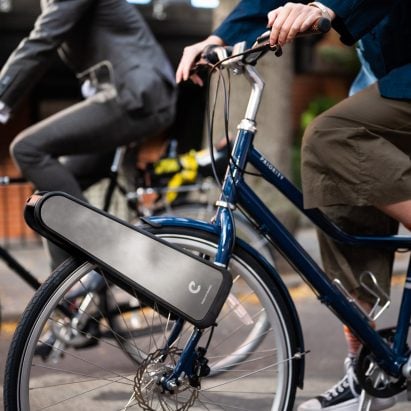Mechanical bike turns into e-bike "in a number of seconds" with CLIP device
CLIP is a portable e-motor device that allows users to alternate between a regular mechanical bike and an electric bike without any tools.Founded in 2018 by Som Ray and Clem De Alcala in Brooklyn, New York, CLIPaims to overcome the constraints of e-bikes and existing e-bike conversion kits.CLIP is a portable e-motor that transforms a regular bike into an e-bike without any toolsAccording to the company, CLIP is the "world's first no tools plug and play solution to upgrade a regular bike into an e-bike".Unlike existing e-bike conversion kits, the format doesn't require the user to make any alterations to their bike before attaching it.The attachment doesn't require users to modify their existing bike before use"The idea was born from my own need while living in Brooklyn I bought a bike to commute to work, but it became a pain because of a long uphill gradient," CLIP co-founder Son Ray told Dezeen."An obvious solution was to get an e-bike, but I'd already invested in my own bike and loved it, and an e-bike is a whole magnitude more expensive," he said.It was created to overcome the pitfalls of conventional e-bikes or conversion kits"I looked at e-bike conversion kits, but they are often painfully complex to set up," said Ray."If you get a Swytch or something similar you have to remove your front wheel and put a new one in, wire it up and put the battery in and essentially end up with an e-bike"."What I really wanted was the flexibility to easily move between analogue and e-bike," Ray explained.The attachment is fitted onto the front tyre of the bikeDesigned as a solution for the urban commuter, the result is a 4kg device which, according to the company, can be attached to almost any bike "in a number of seconds" and can fit inside a backpack.Comprised of aluminium and fireproof nylon with lithium-ion batteries, CLIP provides pedal assist for up to 12 miles, allows for speeds of up to 15 miles per hour and can be recharged in under 60 minutes.A lever which opens the arms of the device also functions as a handleUsers pull a lever to open the arms of the device, which can then be fitted onto the front fork of the bike around the tyre once correctly aligned, users pull down on the clamp to secure the attachment. It can be detached by pulling up the lever to release the clamps."We wanted to keep the user experience simple, so the part used to release the clamps also becomes the handle," said Ray.A friction drive motor powers the bike via a roller that rotates the wheelA motor drives a roller on the main body of the CLIP, which powers the bike's front wheel through friction drive."Mechanically it's not anything new the first motorcycle that was ever conceived was based on the same principle of a roller driving the front wheel," said Ray."It's essentially a small gear driving a larger gear," he added. "We took that same principle and made it transportable".Users press a red button to activate the motor and kickstart the e-bike functionTo activate the motor, users press and hold a red button on a wireless bluetooth controller attached to the bike's handlebar via a rubber loop.A small white button on the same controller can be pressed for regenerative braking, allowing riders to recharge the battery while cycling downhill and extending the range. This remote component was designed to slot into the main dock for recharging and storage.The device weighs 4kg and can be fully recharged in under an hourWhen not in use, CLIP was designed to be compact enough to be easily carried around and stored in the workplace.Ray described the design as "architectural and minimal in its form". "We wanted it to be a product that can sit on your desk next to your laptop and look like it's part of the same ecosystem," he said.Read: Lemmo One bicycle transforms from analogue to electric with a simple attachmentAnother consideration behind the design was to create a product with a lower environmental impact compared to a conventional e-bike."In terms of the sustainability aspects of it, CLIP produces a fraction of the waste and 1/50th of the logistics impact of a typical e-bike," said Ray."We can essentially ship 30 CLIPS for the same volume of that of one e-bike," stated Ray.Other stories about bikes recently featured on Dezeen include an underwater bicycle park created in Amsterdamand a two-in-one bicycle by Lemmo that is both analogue and electric.Photography is courtesy of CLIP.The post Mechanical bike turns into e-bike "in a number of seconds" with CLIP device appeared first on Dezeen.




